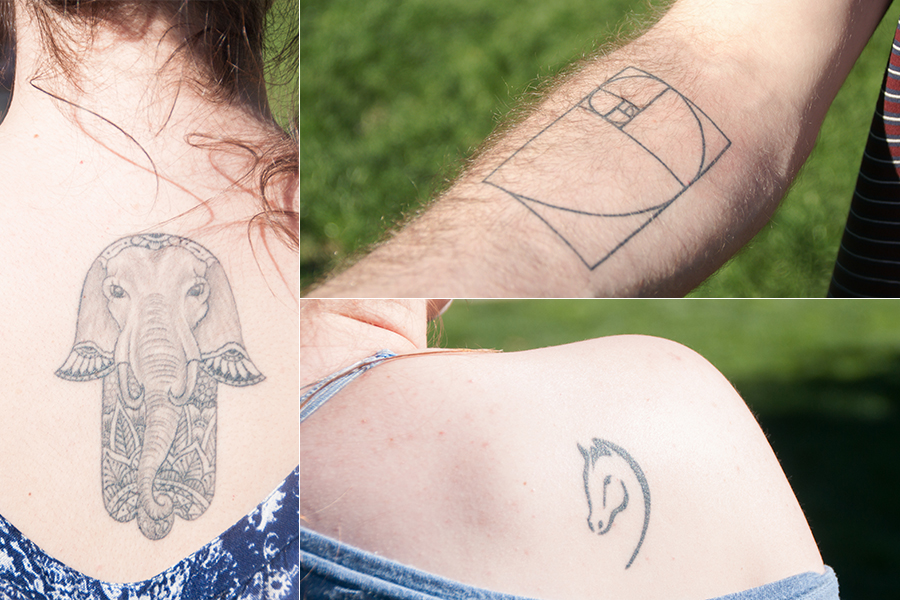
Students explain designs of their tattoos
Tattoos, as art that permanently marks people’s bodies, most often come with a story. Often ambiguous designs hold meanings one could not understand at first glance. Here are a few examples from the UC Davis student body.
Sofia Donovan, third-year biological sciences major
The Aggie: When did you get the tattoo?
SD: “I got the tattoo November of 2015 right after I turned 18, and I had wanted to get the tattoo for a while.”
The Aggie: What’s the story behind your tattoo?
SD: “This tattoo runs in my family. The reason I wanted to get it was that my mom passed away from cancer four years ago in November of 2013. Some of her best friends all have it, too. The physical design itself is the logo of a company that my mom created while she was undergoing treatment. The company is called Pony Expressions, and she sold little gemstone ponies. Cancer has run in my family for a while. Since one of my mom’s parents got cancer, they started this tradition of passing down this little pony, and it comes with a story: There are two twin boys, one’s a pessimist and one is an optimist. And their parents are wondering why they are so different, so they take them to a psychologist. They put the pessimist in a room full of toys, expecting him to play with them, but he starts crying right away worried that he’ll break them. And they put the optimist in a room with horse manure, and he’s flinging it around having so much fun. They ask him why he’s so happy, and he says ‘there has to be a pony in here somewhere.’ So the pony represents in what seems like the worst circumstances you can still find something positive.”
The Aggie: Why is the design so important in the tattoo?
SD: “The design is super important to me since it was my mom’s logo; it makes it that much more special and more tied to my mom. It doesn’t say the word pony or is just a random design. The design is what made me what to get the tattoo.”
Maya Barak, second-year international relations major
The Aggie: When did you get your tattoo?
MB: “I was in Thailand traveling on my gap year. I was in my favorite place in Thailand, Kanchanaburi, and I was close with the local businesses and the people who owned them. There was this one bar next door the hostel I was staying, and there was a tattoo parlor attached to it and I knew the owner of it. One day we got to talking and he asked if he could do a tattoo on me, make his mark on me.”
The Aggie: What’s the story behind your tattoo?
MB: “My tattoo is of a hamsa, which is common in Middle Eastern cultures for the watchful eye. In the middle of it is an elephant whose eyes have a lot of little details. I got it because growing up this is what I always doodled. The tattoo artist and I started doodling together, and the immediate thing I doodled was a hamsa with an elephant on it. I did the basic idea, and he showed me a new one he edited himself. He’s an amazing artist. I think my spirit animal is an elephant because I feel like I’m an old lady, but I have some wisdom to share and I have this spirit animal watching my back.”
The Aggie: Why is the design so important in the tattoo?
MB: “Tattoos are such a form of expression for so many different ways and showing who you are through this stamp on your skin. For me, the design specifically, the design is a doodle I’ve always done as well as the intricate doodles. This speaks a lot about myself and who I am as a person.”
Jake Stebbins, third-year computer science and engineering major
The Aggie: When did you get the tattoo?
JS: “It’s on my right forearm. I got the tattoo in Pittsburgh where I’m from, and my dad bought it for my 20th birthday present and [I] had wanted it since I was about 15.”
The Aggie: What’s the story behind your tattoo?
JS: “It’s the fibonacci spiral inscribed on the golden ratio rectangle. The fibonacci sequence is from a famous infinite sequence, and basically the way you build it is to add the previous two numbers to get the next one and it goes on infinitely. So it comes up a lot in nature and in computing, actually, too. […] the ratio between the fibonacci numbers approaches this number called phi, and that is the golden ratio. This ratio is that, if you make a rectangle with this ratio, you can make an infinite number of rectangles. But this is very pleasing to the eye; it is one of the sacred geometry axioms. When you combine the two, you can create a spiral, like the one on my arm, conch shells or ram horns.”
The Aggie: Why is the design so important in the tattoo?
JS: “It happens a lot in math. As humans we are able to see and observe things and understand how to use them and how they arise. But there is often a disconnect as to why they happen; there are still things we cannot really comprehend. We can find it and calculate it, but why do these things happen in nature? It’s a double-edged sword for me. It’s always wanting to keep up the pursuit of understanding the world around us physically and then also a humbling idea. We are always going to learn new ideas, but there are some things out of our reach. It’s easy to be learning so much and to then think you know everything.”
Written by: Caroline Rutten — arts@theaggie.org




